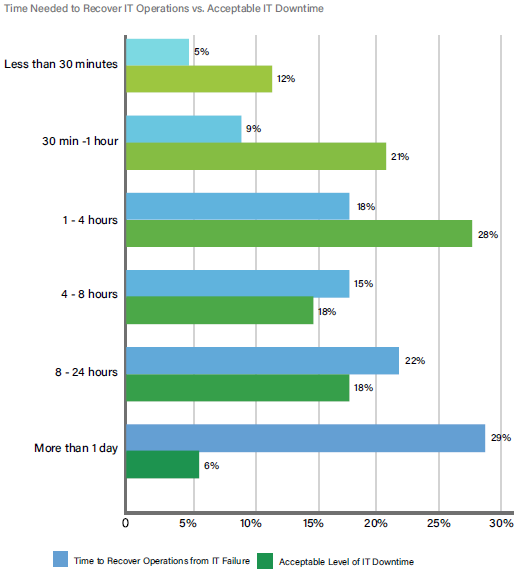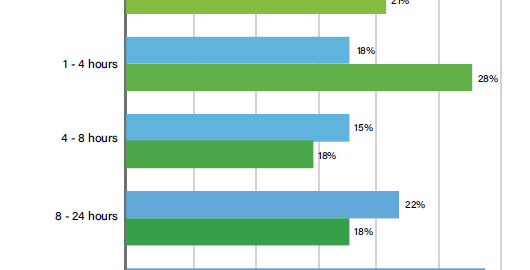A recent survey of 300+ IT professionals conducted by QuorumLabs Inc. revealed that 72% of businesses are unable to meet IT recovery expectations.
To put this into context, let’s use a company’s email servers as an example.
Ask a business executive how long he can work without his email, you get one answer. Ask the IT leader in the same organization how much time is needed to get the email servers up and running after a hardware failure, you get another answer. Typically, the time needed to recover the email servers is longer than the acceptable level of downtime.

The survey revealed a huge gap in acceptable time to recover vs. time needed to recover.
In other words, 72% businesses are not meeting their Recovery Time Objective (RTO) and/or Recovery Point Objective (RPO).
But why? According to Gabe Gambill, VP Products & Operations at QuorumLabs Inc., this typically happens when these situations exist:
A Lack of Communication Between Business Leaders and IT Leaders
The most common scenario is where the topic of data backup and recovery is not even discussed among the executives of an organization. Most business leaders assume that IT leaders got it “taken care of”, while IT leaders assume that business leaders are aware of their current recovery time. This lack of communication can be devastating in the event of an IT downtime.
Ideally, RTO and RPO should be reviewed annually at minimum for both business and IT leaders to sign off. This will bring more clarity and simplify downtime risk management as an organization.
Lack of Reliable, Comprehensive Data Protection & Disaster Recovery Solution
In an ideal world, the product you purchase performs as advertised and sold, and you always get what you paid for. We know that’s not always the case.
Sometimes, when you’re unlucky, the appliance you purchased just happens to be a faulty one. Sometimes a software glitch or a software update disrupts the backup and recovery process. Other times, the data recovery vendor is just not responding fast enough for your support requests.
When selecting a vendor to help you with RTO and RPO, you should always test their reliability using many scenarios. You should also look for online reviews on the vendor’s support. A simple Google search can point you to the most unbiased results. Not getting the proper support can be the biggest bottleneck preventing you from reaching your RTO and RPO objectives.
A Lack of IT Resources Because Data Protection is Not a Priority
Most organizations have enough resources for backup, but not for recovery. That’s because most non-IT leaders understand the importance of backup. However, they don’t understand the importance of recovery.
According to the same survey, only 22% of companies have experienced a major IT failure in the past 2 years. Although IT leaders understand the significance of being prepared for IT failure, getting other executives onboard is especially hard when they haven’t experienced the pain associated with systemwide IT downtime.
This is just normal human behavior. For example, most of us won’t change our diet until a doctor reveals some sort of health issue. We won’t change our behavior until something happens. The same goes with investing in IT recovery, which is why many organizations lack the resources to meet their RTO and RPO objectives. Being prepared for unexpected risks like this is what separates top-performing firms from the others.
Conclusion
When a systemwide IT failure does occur, each minute costs the business an average of $ 5,600, or over $ 300K per hour, according to Gartner. This cost of downtime can devastate businesses that are not prepared for a systemwide failure. If you want to avoid this, then you should start a conversation with your organization’s leaders.
To see other key findings from the survey, download the 2020 Disaster Recovery Survey Whitepaper.
Business & Finance Articles on Business 2 Community
(44)
Report Post




